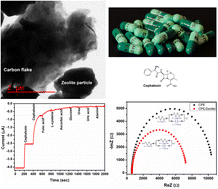Enhanced and selective electrochemical sensing of cephalexin using zeolite/CPE
Abstract
The present research investigated the electrochemical sensing of cephalexin via a modified carbon paste electrode (CPE) with zeolite (zeolite/CPE). The morphological and structural properties of zeolite/CPE were studied using field emission scanning electron microscopy (FESEM), high-resolution transmission electron microscopy (HRTEM), Fourier-transform infrared (FTIR), and Raman spectroscopies. Electrochemical impedance spectroscopy (EIS) measurements indicated a higher charge carrier lifetime (28.05 ms) for zeolite/CPE compared to CPE. Cephalexin electrochemical sensing using zeolite/CPE was examined in detail utilizing cyclic voltammetry (CV), differential pulse voltammetry (DPV), and chronoamperometry experiments. Different performance parameters such as the zeolite:CPE ratio and pH were optimized. The sensing measurements were performed at different cephalexin concentrations and scan rates. The increased cephalexin concentrations enhanced the current amount of the oxidation peak and showed a linear relation. Using the modified electrode and increasing the scan rate also improved the current amplitude of the sensor due to the rapid carrier-transfer kinetics of zeolite/CPE compared to the CPE. Moreover, DPV measurements confirmed the improvement in sensing properties when zeolite particles were used. The reliability, long-term performance, and stability of zeolite/CPE were tested using different experiments. Finally, the sensing mechanism was explained with the possible process from the obtained results.



 Please wait while we load your content...
Please wait while we load your content...